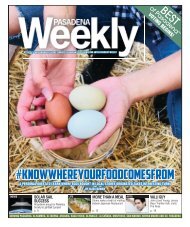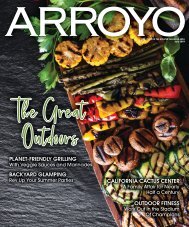08.16.18
You also want an ePaper? Increase the reach of your titles
YUMPU automatically turns print PDFs into web optimized ePapers that Google loves.
HOW TO LOVE A BEE<br />
CONTINUED FROM PAGE 09<br />
They thought that bees brought human souls back to the earth. These are ancient<br />
mysteries that have been going on for thousands of years. I started delving into it a little<br />
bit more; I practice meditation and I chant, so something resonated with me … like a<br />
soul connection with this animal. I didn’t even know that there were all sorts of rituals<br />
and temples and priestesses called the Melissae in Greece that would do ceremonies to<br />
honor the bee. I found that fascinating. Why wouldn’t we honor a creature that feeds our<br />
population?”<br />
Jordana, who grew up on his grandfather’s farm in the Philippines, conducts breathing<br />
exercises with jittery guests and other visitors (including the Zooey Deschanelhosted<br />
web series “Your Food’s Roots,” which recently shot a still-unaired episode in<br />
his backyard). He doesn’t want anyone to be stung, nor does he want to “stress out” his<br />
bees, about which he’s quite protective.<br />
“You have to move slow around them,” he says. “You can’t be afraid. This goes back<br />
again to the spiritual practice. You have to be very present. All these are tenets of meditation<br />
and mindfulness. You’re kind of forced to do it [laughs] when you’re around bees.”<br />
Jordana maintains 10 hives within a five- to eight-mile radius at his home, a community<br />
garden and friends’ backyards. He trades honey for pomegranates and figs, and<br />
habitat.<br />
“I’ve never done it for sale — I’m not pimping out my girls like that,” he says with a<br />
laugh. “If I do take some honey, I take very little — just enough for me, my friends and<br />
family. It’s cool because there’s a sense of community in it. I trade to be able to put my<br />
beehives in people’s backyard for honey. There’s something very ancient about it; it’s a<br />
commodity that’s shared that’s not monetary.”<br />
The beekeepers who spoke (on and off the record) for this article are mindful of<br />
not taking too much honey. As Brewster points out, the more you take, the harder and<br />
longer bees need to work. That’s particularly problematic if they’re dealing with other<br />
environmental stressors. But the conscientious bartering that occurs around urban<br />
farming fosters deeper ties of community as well as greater awareness of food’s production<br />
and provenance.<br />
HONEY IN THE HIVE<br />
In May the nonprofit Bee Informed Partnership (beeinformed.org), which conducts<br />
annual surveys of US honeybee colony loss, released its preliminary analysis of that<br />
loss between April 2017 and April 2018. With 69 percent of backyard, sideline and commercial<br />
beekeepers declaring that they “lost more of their colonies than deemed to<br />
be acceptable,” Bee Informed estimated that US beekeepers lost 40.1 percent of their<br />
managed honeybee colonies — more than the previous year (33 percent). Such continuing<br />
high percentages of lost colonies are, according to beekeepers as well as a June 2014<br />
Obama administration Fact Sheet, unsustainable.<br />
That same Fact Sheet called insect pollination “integral to food security in the<br />
United States,” and credited pollinators with contributing upwards of $24 billion to the<br />
US economy; honeybees accounted for more than $15 billion of that, and the contributions<br />
of “native wild pollinators, such as bumble bees and alfalfa leafcutter bees”<br />
reached more than $9 billion.<br />
The chief threats confronting domestic and wild bees are climate change, habitat<br />
loss, and pesticides — particularly the neuro-active class of chemicals known as neonicotinoids,<br />
which make bees vulnerable to their primary predator, the parasitic varroa<br />
mite. Yet earlier this summer, the Trump administration reversed a two-year-old ban on<br />
neonicotinoid usage on wildlife refuges instituted during Barack Obama’s presidency.<br />
Against that backdrop, commercial beekeepers find their bees more in demand<br />
than ever as they rotate “hives for hire” from berry farms to cantaloupe fields. There<br />
are strong anecdotal signs that bees are being stressed and consequently weakened<br />
by such moves. According to July’s National Honey Report from the US Department<br />
of Agriculture, bees were being fed protein patties and sugar syrup as nectar sources<br />
remained scarce in June (“another disappointing month” due to winter drought). The<br />
overall honey crop was improving, but keepers voiced hope that pesticide exposure will<br />
be minimal so their bees can survive winter.<br />
Meanwhile, two percent of wild bee species are responsible for pollinating approximately<br />
80 percent of the world’s bee-pollinated crops, per a 2015 study published in the<br />
Nature Communications journal. The value of wild pollinators transcends economics;<br />
they are crucial to biodiversity. And according to both Brian Brown and horticulturalist<br />
Carol Bornstein, director of the Nature Gardens at the Natural History Museum in Los<br />
Angeles, native bees are in more trouble than honeybees, due to habitat loss and indiscriminate<br />
pesticide usage. (A survey is being conducted now, at the height of the bee<br />
season, of all the native bee species the Nature Garden is attracting via its native plants.<br />
Sampling is still taking place but Brown anticipates results within a couple of weeks.)<br />
While logic (if not scientific data) dictates that backyard beekeeping boosts bee<br />
population numbers, those are honeybees, which are great for pollinating fruit trees<br />
and other edible plants.<br />
“I think it’s important to mention that native bees are excellent pollinators as well, in<br />
some cases far more efficient than European honeybees,” Bornstein says. “And I think<br />
it’s preferable to plant native plants because those are some of their food sources from<br />
an evolutionary standpoint; that helps local populations of bees whose historically used<br />
plants have definitely shrunk in population size and numbers. You don’t need to create<br />
a hive, you just need to plant the plants — in the sunflower family, the mint family, the<br />
carrot family, native buckwheats.”<br />
TO HIVE OR NOT TO HIVE<br />
Brewster credits a friend with helping his family start their hives. Jordana says he<br />
10 PASADENA WEEKLY | <strong>08.16.18</strong><br />
CONTINUED ON PAGE 14

















